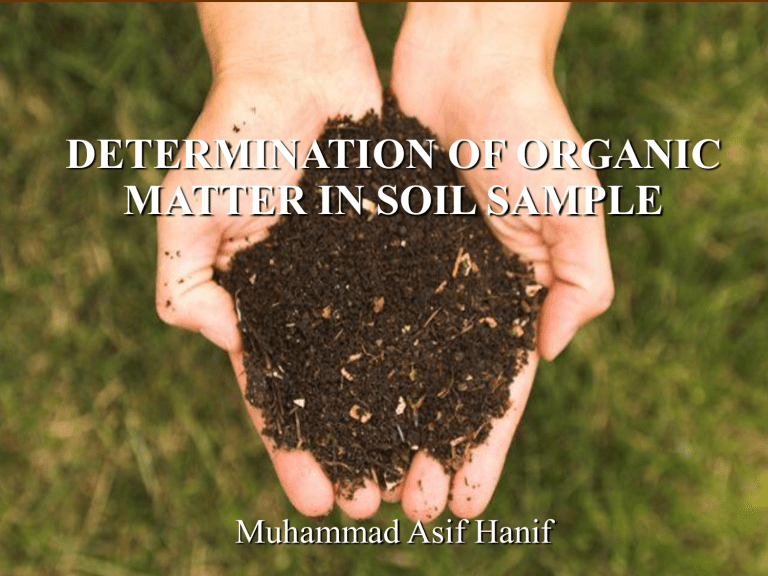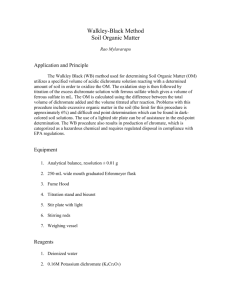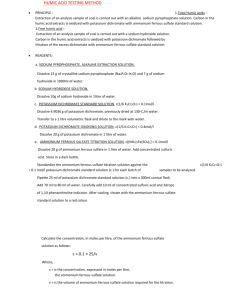Organic-matter - Dr. Muhammad Asif Hanif

DETERMINATION OF ORGANIC
MATTER IN SOIL SAMPLE
Muhammad Asif Hanif
Organic Matter
Soil organic matter represents the remains of roots, plant material, and soil organisms in various stages of decomposition and synthesis, and is variable in composition.
Though occurring in relatively small amounts in soils, organic matter (OM) has a major influence on soil aggregation, nutrient reserve and its availability, moisture retention, and biological activity.
Organic Matter
Organic carbon (OC) ranges from being the dominant constituent of peat or muck soils in colder regions of the world to being virtually absent in some desert soils. Most laboratories in the region perform analysis for soil organic matter.
The most common procedure involves reduction of potassium dichromate (K
2
Cr
2
O
7
) by OC compounds and subsequent determination of the unreduced dichromate by oxidation-reduction titration with ferrous ammonium sulfate.
Organic Matter
While the actual measurement is of oxidizable organic carbon, the data are normally converted to percentage organic matter using a constant factor, assuming that OM contains 58% organic carbon.
However, as this proportion is not in fact constant, we prefer to report results as oxidizable organic carbon, or multiplied by 1.334 as organic carbon.
Pre-Lab Questions
1. What is difference between organic matter and humus?
2. What is difference between organic matter and compost?
Apparatus
Magnetic stirrer
Teflon-coated magnetic stirring bar.
Glassware
Pipettes for dispensing
Preparing reagents
Titration apparatus (burette).
Reagents
A.
Potassium Dichromate Solution (K
2
Cr
2
O
7
),
Dry potassium dichromate in an oven at 105
°
C for 2 hours, cool in a desiccator (silica gel), and store in a tightly stoppered bottle.
Dissolve 49.04 g potassium dichromate in DI water, and bring to 1-L volume with DI water.
B.
Sulfuric Acid (H
2
SO
4
), concentrated (98 %, sp. gr. i.84)
C. Orthophosphoric Acid (H
3
PO
4
), concentrated
D.
Ferrous Ammonium Sulfate Solution I(NH)
2
M
SO
4
.FeSO
4
.6H
2
O, 0.5
Dissolve 196 g ferrous ammonium sulfate in DI water, and transfer to a
1-L volume, add 5 mL concentrated sulfuric acid, mix well, and bring to volume with DI water.
E. Diphenylamine Indicator (C
6
H
5
)
2
NH
Dissolve 1 g diphenylamine indicator in 100 mL concentrated sulfuric acid.
Procedure
1.
Weigh 1 g air-dry soil (0.15 mm) into a 500-mL beaker.
2.
Add 10 mL 1 N potassium dichromate solution using a pipette, add 20 mL concentrated sulfuric acid using a dispenser, and swirl the beaker to mix the suspension.
3.
Allow to stand for 30 minutes.
4.
Add about 200 mL DI water, then add 10 mL concentrated orthophos- phoric acid using a dispenser, and allow the mixture to cool.
5.
Add 10 - 15 drops diphenylamine indicator, add a teflon-coated magnetic stirring bar, and place the beaker on a magnetic stirrer.
6.
Titrate with 0.5M ferrous ammonium sulfate solution, until the color changes from violet-blue to green.
7.
Prepare two blanks, containing all reagents but no soil, and treat them in exactly the same way as the soil suspensions.
Calculations
Percentage Organic Matter in soil:
10
M = ............................................................. (16)
Vblank
[Vblank - Vsample] x 0.3 x M
% Oxidizable Organic Carbon (w/w) = ----------------------------------------- (17) wt
% Total Organic Carbon(w/w) = 1.334 x % Oxidizable Organic Carbon .... (18)
% Organic Matter (w/w) = 1.724 x % Total Organic Carbon
Where: M = Molarity of ferrous ammonium sulfate solution
(approx. 0.5 M)
V blank = Volume of ferrous ammonium sulfate solution required to titrate the blank (mL)
Vsample = Volume of ferrous ammonium sulfate ferrous ammonium sulfate solution required to titrate the sample (mL) wt = Weight of air-dry soil (g)
0.3 = 3
×
10 -3 ×
100, where 3 is the equivalent weight of C.
Note
1.
For soils high in organic matter (1% Oxidizable Organic
Carbon or more), more than 10 mL potassium dichromate is needed.
2.
The factors 1.334 and 1.724 used to calculate TOC and
OM are approximate; they may vary with soil depth and between soils.
3.
Soils containing large quantities of chloride (Cl ), manganese (Mn 2+ ) and ferrous (Fe ++ ) ions will give higher results. The chloride interference can be eliminated by adding silver sulfate (Ag
2
SO
4
) to the oxidizing reagent. No known procedure is available to compensate for the other interferences.
4.
The presence of CaCO
3 up to 50% causes no interferences
Post Lab Questions
1. How much organic matter is present in fertile agricultural soils?
2. How organic matter content of soils can be improved?











